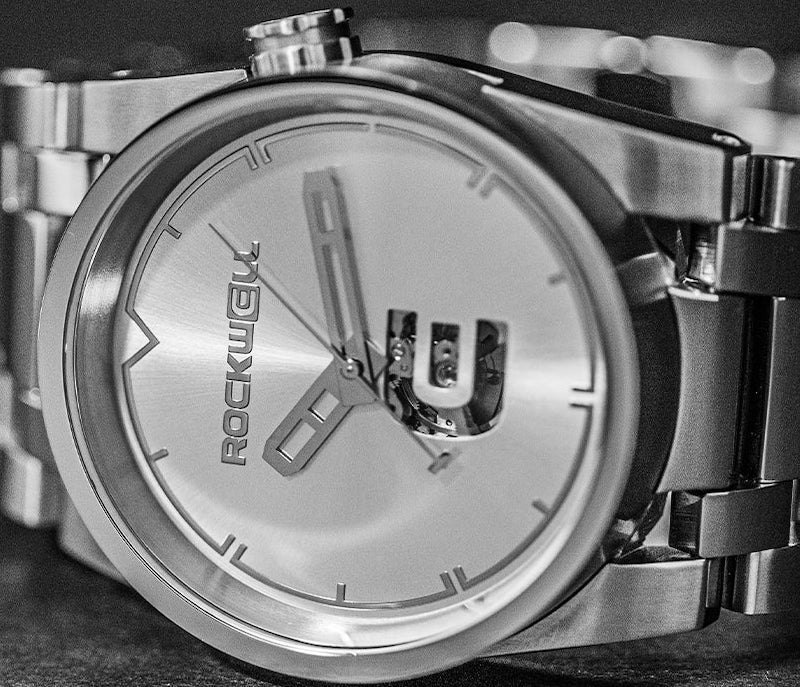Automatic watches are a fascinating fusion of history and science. From their modest origins to the stunning works of craftsmanship we see today, the automatic watch continues to be a timeless time-telling legend. And while they may seem relatively simple in concept and design, these horological works of art are anything but.
You’ve probably gathered that automatic watches run–well–automatically. Seems pretty straightforward, right? Wrong. These little beauties are full of mechanical mysteries waiting to be discovered, and their conception and evolution are just as fascinating. So, get ready to nerd out a bit; it’s time to unravel the mysteries of the automatic watch.
1. Automatic movement runs on kinetic energy.
What’s the best way to keep your automatic ticker ticking? By wearing it. Automatic watches harness the energy from the natural movement of the wearer’s wrist to spin the rotor, which sends energy to the movement mechanisms. This allows these watches to deliver accurate and reliable time as long as they are being wound frequently, which is why many consider automatic watches their “daily driver.”
2. Pocket watches were the first timepieces to feature automatic movement.
Clockmakers began experimenting with the concept of automatic movement in the 1700s. In 1776, Swiss watchmaker Abraham-Louis Perrelet invented the first recorded self-winding mechanism in a pocket watch, which required 15 minutes of walking in order to be fully wound.
3. Automatic wristwatches were first designed for women.
Back in the day, every guy with half a grain of fashion sense carried around a pocket watch. But ladies who wanted to be able to keep tabs on time didn’t have the convenience of pockets, so a pocket watch wasn’t really an option. Women had been wearing timepieces on necklaces, but this didn’t provide the movement necessary to power automatic movement. The first recorded wristwatch was designed by Abraham-Louis Breguet for Queen Caroline Murat of Naples in 1810, and soon became quite the trend among the ladies.
4. World War I created a need for automatic wristwatches.
Having to reach into one’s pocket, pull out a watch on a chain, and release the casing to tell time wasn’t a big deal when times were peaceful. However, a world war brought with it a new kind of urgency. Soldiers and pilots didn’t have time for pocket watches. They needed accurate time and they needed it fast. So, expert horologists answered the call with one of the world’s most reliable tactical tools: the automatic wristwatch.
5. You can wind most automatic watches by hand.
While automatic movement watches are known for winding themselves, they sometimes need to be wound by hand. Before donning your new automatic watch, you’ll likely need to give it a good wind to set the time. The same goes for a timepiece that’s been sitting in a drawer for a while.
6. There’s no such thing as over-winding.
In the early days of automatic time telling, too much movement from the wearer could over-wind the mainspring, causing it to snap. Luckily, watchmakers developed a way for the mainspring to disconnect when it senses excessive motion. This allows the winding to pause, protecting the mainspring from snapping.
7. Automatic watches need to be serviced regularly.
They might have mastered self-winding, but as of yet, automatic watches haven’t unlocked any self-care functions. In order to remain accurate, reliable, and in tip-top shape, automatic timepieces require regular maintenance. How regularly are we talking? That all depends on the watch. Your manufacturer’s manual should include model-specific guidelines for care, but you can also take the watch to an authorized servicing facility for recommendations.
8. Automatic watches require expert skill and craftsmanship to produce.
The intricate inner-workings of automatic movement cannot be mass produced. Building an automatic watch requires careful attention, a skilled hand, and the talent of a master craftsman. They take time and attention to detail, which is why you’ll often see a higher price tag on an automatic watch than their battery-operated counterparts.
9. Automatic watches are sustainable.
In today’s society, people are a lot more concerned with being “green” and “eco-friendly” than they used to be. Many want to make sure their purchases are doing less harm to the planet, which is why many environmental enthusiasts opt for automatic watches, which don’t need batteries to power them.
10. An automatic watch exudes luxury, class, and sophisticated style.
Luxury automatic watches are more than an accessory: they’re a symbol of status and style. These sleek and sexy timepieces send a message that the wearer values quality craftsmanship, tradition, reliability, and elegance. They can compliment a business suit while also somehow looking super rad when paired with jeans and a t-shirt. Their classy versatility makes them the perfect accessory for any day and any occasion and are sure to add style points to any look.
Automatic Watches are a Cut Above
Understanding the history, mechanics, and features of automatic watches just makes us love these incredible timepieces all the more. Although they may seem simple when compared to their tech-heavy digital counterparts, these products of craftsmanship and precision deliver unmatched quality and reliability. So, if you’re looking for an accessory that you can count on, now’s the time to invest in an automatic watch.
